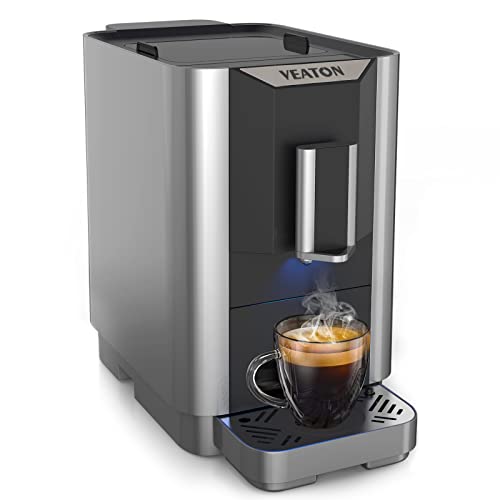How to Maintain Espresso Machines
Espresso drinks are beneficial to businesses such as hair salons and doctors' offices, and car dealerships. Serving these beverages can improve customers' patience when waiting for service and enhance the atmosphere of your establishment.
A Good Housekeeping 2022 Espresso Machine winner, this revolutionary machine utilizes smart dosing technology to weigh and dispense the perfect amount of ground coffee for each shot. It also includes an espresso frothing wand, which did exceptionally well in our tests of producing steam-frothed milk.
The Basics
Espresso machines are an excellent addition for any office or home. They can be used to prepare various drinks, including cappuccinos and lattes. They work by forcing hot water through ground coffee under pressure. This results in a concentrated shot that is full of flavor. It has a significant amount of caffeine, which can be an effective stimulant.
These types of machines are available in a range of sizes from compact models that are perfect for homes to larger models designed for commercial use. They are available in manual and semi-automatic versions. Manual machines require the user to control the flow of water and pressure while semi-automatic models have an integrated pump that can do this for you. Some semi-automatic models include grinders while others do not. The kind of machine you decide to purchase will be based on your personal preferences and budget.
The manual espresso machine is operated by turning a handle which forces water through the grounds of a filter basket. This kind of machine is often called caffettiera or macchinetta, and is the most popular type of espresso maker. It is equipped with a bottom chamber that holds the water, and a top chamber with an iron filter. When heated, the steam is pushed through the coffee grounds before being pushed into the top of the machine. There, the espresso is ready to be served.
Varieties
Depending on your needs the options are endless. You can choose from a variety of espresso machines . These include manual, semi-automatic and fully automatic coffee machines. Each machine has its own unique method of making espresso shots and other beverages like lattes and cappuccinos.
The first machines were not completely automated, requiring the user to operate a lever manually that created the pressure required to pull a shot of espresso. Although they are still available, they are not as common because they require lots of effort and can be very tiring to operate. Modern espresso machines utilize various mechanisms to generate pressure such as push, screw and see-saw designs. This lets users regulate pre-infusion, volume of water and pressure more precisely than a lever machine.
Pump-driven espresso machines are similar to stovetop mokapots, however, they use an electric motor to press the grounds of coffee instead of steam. They have a boiler that brings the water to a boil then a pump forces it through a group head to the coffee. These are the most commonly used kinds of espresso machines and they're usually less expensive than other types.
Semi-automatic espresso machines blend the best features of both the pump-driven and manual espresso machines. They let you grind the beans and then tamp them, however motors control the pressure to ensure consistency. Some models have a separate compartment for heating and frothing milk.
Functions
Commercial espresso machines can make a broad range of coffees, including espressos, at the touch of one button. They use pre-packaged coffee pods that are precisely dosed and packaged to produce one cup of coffee or espresso. These sleek machines eliminate the need for a grinder, dosing and tamping, which makes them an ideal choice for busy offices. Since they lack steam functions, a separate milk froth is required to make cappuccinos and lattes.
Many cafes across Europe employed steam machines to boost production and cut down on brewing times. These early machines were heated by an open flame which led to an inconsistent temperature and pressure. Inventor Angelo Moriondo of Turin, Italy is believed to have invented the first machine that was capable of brewing espresso without using steam.
The most popular kind of espresso machine available today is a pump-driven machine. They use a portafilter to store the ground espresso beans. When the valve is set to the espresso position the water is pumped at 15 atmospheres pressure from the heating vessel. When the brew is finished, the portafilter is removed and the drip tray emptied to be cleaned.
Automatic espresso machines add automation to semi-automatic systems by controlling the extraction time in accordance with volumetric or internal timers. They also eliminate the barista’s ability to tamp or grind coffee, which could affect the quality of the final product.
Maintenance

Espresso machines may not be the most attractive equipment in a café, but they're extremely important. The way you maintain your espresso machine will affect the taste and quality of your beverages.
Clean espresso machines ensure that the taste of your coffee will not be ruined and your customers' experience will be great. Maintaining a regular routine cleanings and maintenance can also increase the lifespan of your espresso machine, ensuring it can last for a long time.
Use a damp cloth to clean the baskets and portafilters each shift to get rid of any oils or residues. Backflush the gasket between the head of the portafilter and the grouphead by inserting the nylon brush and moving it to eliminate any build-up. Rinse off the gasket then repeat the process until the water runs clear.
Every week or when required, mix espresso machine cleaner into a container of water, following the manufacturer's instructions. Then, soak the portafilters and baskets in the cleaning solution overnight. If your espresso machine has steam wands, take out the screen and wand from the set using a screwdriver and soak them separately in the cleaning solution.
